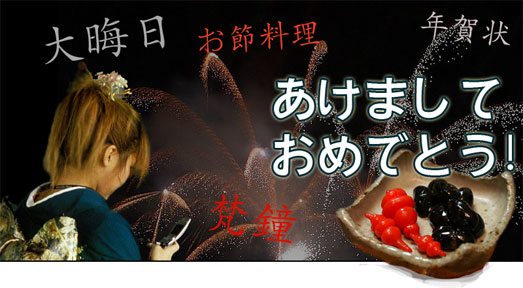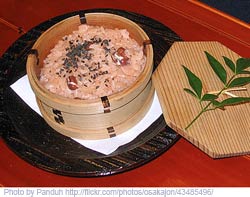
The Japanese new year’s celebrations, 正月, Shougatsu, is one of the most important holidays and festivities in Japan. Read more about New Year and the vocabulary connected to it in Shizu’s article.
Please note that translations of the Japanese words in the text are available within the parenthesis if you hold your mouse pointer over the gray box or make a selection over the box within the parenthesis.
Hello everyone, “Our boss” Johan told me that you must be interested in matters about our お正月(おしょうがつ – oshougatsu = new year days), so I’ll tell you about that with a great pleasure.
Starting with the Greetings
Let’s start from the greetings. In English, you say “A happy new year!” as a greeting around this season, right? We use the two phrases below, and you should note when you use them.
- 明けましておめでとうございます。
- Akemashite omedetou gozaimasu.
- よいお年を。
- Yoi otoshi o.
Maybe lots of you already know the first expression, I guess. “Akemashite” means “opening (new year)”, “beginning (new year)” or something like that, so using the phrase now is odd. Namely, you say this from beginning of a new year.
About the second expression: “yoi” means “good”, and “toshi” means “year”. This phrase is omitted some words, and maybe this complete one is:
- よいお年をお迎えください。
- よいおとしをおむかえください。
- Yoi otoshi o omukae kudasai.
or
- よいお年をお過ごしください。
- よいおとしをおすごしください。
- Yoi otoshi o osugoshi kudasai.
The direct translation is a little difficult and might be funny possibly, but anyway it indicates your feelings to others “Have a nice time for the holidays”, “I hope your new year will be fine for you” or something like that. By the way, normally we say this phrase only once to a person. Instead of saying “Bye/See you” to your friend today, you can say “yoi otoshi o” if you know (or believe) that you won’t see the person anymore until the beginning of new year. But if you know that you see him/her again by the end of this year, you don’t say this phrase.
Traditions – First, Make it Nice and Clean
One of our important (and tiresome) customs is 大掃除(おおそうじ – oosouji = cleaning up thoroughly). When I was a child(I’m 44 years old now), we used do this event on 31th of December together with all of family. Even though you clean your house every day, we do all over the house especially about places that we didn’t care too much. Lots of business offices finish the work around 29th of this month, and maybe every worker must do 大掃除 (oosouji) at that day. Recently every family member has their own work, so possibly you must do such cleaning about your working place and home as well. By the reason, it seems that more people do 大掃除 every day little by little around this season. Although it’s a little strange to think of the meaning of 大掃除…
Traditional Dishes
 We called 大晦日(おおみそか – oomisoka)” for new year’s eve, and lots of us prepare for special cuisine called おせち料理(おせちりょうり – osechi ryouri). Normally we cook it until evening of 大晦日 (oomisoka), but recent busy people buy really expensive and stylish osechi by great cooks in famous hotels and restaurants etc. They sound and look tasty truly, but our traditional food might be ignored.
We called 大晦日(おおみそか – oomisoka)” for new year’s eve, and lots of us prepare for special cuisine called おせち料理(おせちりょうり – osechi ryouri). Normally we cook it until evening of 大晦日 (oomisoka), but recent busy people buy really expensive and stylish osechi by great cooks in famous hotels and restaurants etc. They sound and look tasty truly, but our traditional food might be ignored.
By the way, apparently osechi is tasted from beginning of the new year. Generally we eat そば (soba – buckwheat noodles) at the night of oomisoka simply. Here in Hokkaido, lots of people enjoy lots of dishes at that night, so I was surprised at the fact, lol. Anyway, eating soba is meaningful. A soba is a loooong stuff, and it seems indicate our wish – good things will be continued longer.
What to Do on New Years Eve
If you live in quiet place, you can hear the sound of a big bell from a temple around midnight. The sound is awesome and calm so that you can think of the year which is going to pass. The tolling sound is 108 times, but it might be difficult to hear them if you’re laughing watching TV, or because of snow storm, lol.
Well, personally I (and my family) decide to go to bed around midnight, but lots of people seem to leave to shrine. Some of them go to a shrine nearby, and some of them go to bigger or more famous one. Some of them want to arrive there before the beginning of the new year, so they must leave from their home earlier. A shrine is like a church for Shintoists, but now it’s meaningless for us religiously. Therefore, you can go to any shrines regardless of your religion. The main purpose for visiting there is praying for the new year. One or more Gods live in each shrine, and you can ask your wish to him/them – good health for your family, improvement of your study or success of your work, finding a good partner of your life, peaceful life without bad happening etc etc etc. Each shrine has a big box for money, and you put some coins into the box when you wish something. Some of people buy お札(おふだ – ofuda) which is like a good luck charm, I think. I’m not interested in such stuff, but some people (especially shop’s owner and president of a company etc) might visit to a shrine every year to buy the ofuda for their success with the work.
Well, once our New Year’s Days (1-3th of Jan.) were completely holidays, so we had to buy lots of stuff until the eve. Osechi is cooked enough so that we can eat for such days, and we eat also もち (mochi – a sticky rice product) and the cuisine with mochi as our typical food for new year’s days. But the time has changed indeed. Now we can buy anything any time at supermarkets, convenience stores, department stores etc, and lots of restaurants open. Lots of people have to work – also taxi drivers not only shop’s workers. It’s certainly more useful, but I sometimes miss the quiet New Year’s Days. I live in Sapporo which is a big city, and perhaps new year’s days are more joyful if you spend in country rather than noisy great town. Around here, the differences between new year’s days and usual days decrease more and more, I feel. Oh, one thing which doesn’t change: we’re looking forward to receive 年賀状(ねんがじょう – nengajou = which is new year’s card) in the morning of the 1st.
お年玉
For lots of children, oshougatsu is the happiest time with money. They can expect getting money from their parents (from father mainly) and grand parents and possibly relatives. As soon as children found their relatives will visit them during oshougatsu, they start counting money and thinking about the way of spending. This money called お年玉(おとしだま – otoshidama) and the word seems to mean that being your soul for a new year. We say 魂(たましい – tamashii) in Japanese for “soul”, and it’s replaced another word 玉(たま – tama) from お年玉. It’s a kind of word game, and people of Edo period used to like such a game, I hear.
Buying Happy Bags
If you like do shopping, you must be looking forward to buy 福袋(ふくぶくろ – fukubukuro) which means “happy bag”. Mostly, the paper bag is red with write letter 福袋, and you can’t see what the bag has in. One exact thing is that you can find more expensive stuff than you pay. For example, if you buy a fukubukuro of 5000 yen in a boutique, maybe you can find stuff which is 10000 – 15000 yen possibly. Maybe you can find some clothes or other things which are sold at the boutique from the fukubukuro, but nobody can know the design and the color etc. Personally I used to like buying fukubukuro of imported sweets. It was not so expensive, and I found the bag had Belgian cookies, chocolates, jam from England and tea bags.